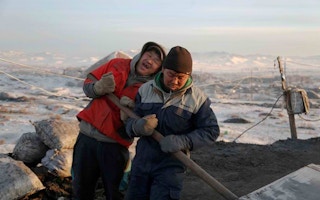Thermal coal is the number one cause of global temperature rise. It is responsible for nearly half of carbon dioxide emissions worldwide and 72 per cent of greenhouse gas (GHG) emissions from the energy sector. A report by the Intergovernmental Panel on Climate Change (IPCC), released in August 2021, issued a “code red” for the world, warning that without deep and immediate cuts to carbon pollution — including the phase-out of coal — the 1.5°C goal of the Paris Agreement “will quickly fall out of reach.”
If the transition and eventual departure from coal to renewable energy does not materialise, development — particularly in lower-income countries where most coal is burned — will be unsustainable economically, socially and environmentally.
A study of air pollution in Southeast Asia found that fossil fuels are responsible for 82 per cent of low-visibility days, and the burning of coal is a major source of nitrogen oxides, sulfur dioxide, particulate matter and heavy metals in the air, polluting the air, water and soils. An estimated 20,000 people die every year from respiratory illnesses linked to coal power in Southeast Asia, South Korea, Japan and Taiwan. That death toll will grow to 70,000 annually by 2030 if coal plants that are currently being built or at the planning stage go ahead in these territories, according to researchers at Greenpeace and Harvard University.
A future without coal: guidelines and recommendations
A recent report commissioned by non-profit organisation (NGOs) Fair Finance Asia (FFA), A future without coal: Banking on Asia’s just energy transition, laid out policy guidelines and recommendations for governments and financial institutions to move away from coal and towards a just transition.
Taking a helicopter view, the researchers and writers spoke to a cross-section of stakeholders, from representatives of financial institutions and the private sector to policymakers and a range of NGOs from both industrialised Asian nations and emerging economies. With key regional and national policy developments in China and Southeast Asia as background, the report focused on the impact of coal and the role of financial institutions in the transition from coal to renewables.
“
Phasing out coal means phasing out unsustainable practices that no longer align with the future of people and our planet.
Bernadette Victorio, programme director, Fair Finance Asia
The world remains heavily dependent on coal. Over one-third of global electricity generation comes from coal, which powers energy-intensive industries such as iron and steel. Its entrenchment in development is a key reason why governments are finding it so hard to transition and to completely cut coal out.
The decision text of the COP26 climate talks was supposed to consign coal to history, but a last minute intervention by India diluted the language to “phase down” unabated coal use. China, which consumes about a third of the world’s coal, also obstructed a deal on coal at COP. Indonesia has pledged to wean itself off coal and achieve carbon neutrality by 2060, but still has scores of new coal plants in development.
Meanwhile, renewable energy prices are tumbling but coal still enjoys broad support in many developing countries whose economies are built around the fossil fuel. FFA’s study indicates that Asia continues to heavily finance coal and is broadly less eager to fund renewable energy. There are three main reasons for this:
- The absence of a regulatory framework to incentivise Asian financial institutions to fund the transition;
- Large energy companies in Asia are not developing sufficient, large renewable energy projects, and financial institutions are not interested in financing smaller renewable energy projects;
- Asian governments are not investing in electrified transport infrastructure.
The energy transition requires new infrastructure development, new technologies and retraining of fossil fuels workers for clean energy jobs. From the perspective of governments and banks, investment in coal is sunk costs already made, the report reads.
Fossil fuels make up 85 per cent of China’s energy mix, and meeting the country’s 2060 net-zero emissions target, announced in September this year, will cost the country an estimated US$163 billion a year.
Fixing coal’s abuse of human rights
Against this backdrop of coal reliance is the violation of human rights associated with the sector, particularly in Asia, where most of the world’s coal is mined and burned.
Traditionally, the coal industry has lacked policies and protections regarding child labour, the wellbeing of coal-miners, transporters and workers in coal processing plants and their families, vulnerable communities who live and work near coal mines, and the rights of the rural and indigenous communities who live on the lands that have been gazetted for the coal sector.
Coal-fired power plants emit harmful and hazardous chemicals that pollute the air and cause respiratory and ocular diseases. Run-off from coal mines and processing plants contaminate waterways, affecting crops and fish life. This directly affects the communities who depend on the land near and around the mines and plants.
A report by the Guardian newspaper in February found thousands of children and men living on US$5 a day working in coal mines in Pakistan, one of Asia’s largest coal producers. In the story of the mine in Balochistan, Pakistan, there were barely any health and safety measures, brutal working and living conditions, and the hallmarks of modern slavery, including debt bondage.
Replacing coal is not necessarily a straightforward solution because we could create new imbalances in the global energy chain if we make the same mistakes we did with fossil fuels, says Bernadette Victorio, FFA’s programme director and one of the authors of the study.
A just transition is one that respects the needs of workers, community members, businesses and local governments, and is an opportunity to remedy the wrongs wrought by the burning of a fuel that represents 40 per cent of global fossil CO2 emissions, she says. Asian countries, particularly in coastal areas, are set to bear the worst effects of climate change, and the continued burning of coal will exacerbate those impacts.
Developing and transferring job skills from coal to renewable energy
In the move towards renewable energy, knowledge of the environmental and social hazards of coal, and how the damage caused by coal was allowed to proliferate, is key. Governments need to ensure that policies are put in place to support a transition that respects human and labour rights, says Victorio.
When both the public and private sectors are more willing to invest in renewable energy as a viable industry, opportunities abound for training and apprenticeship programmes. Jobs and transferable skills can come in the form of construction work for plants and installations.
Technicians can be given upgrades on system design and energy analytics. Impact accessors and health inspectors can be trained. Maintenance crew will always be needed for the installations. This manpower can come from local communities around where clean energy plants are situated. Solar and hydroelectric plants can be built and run on a smaller scale at the village level, accessible by local communities.
The clean energy future is bright, even in a region whose energy demand growth is 80 per cent reliant on coal-fire power. It just needs commitment, an urgency to change and an understanding that change is inevitable as market trends shift away from coal, says Victorio.
Demand for coal dropped 4 per cent in 2020, not only because a Covid-19 induced slump in energy demand but because more governments are beginning to wean themselves off the polluting fossil fuel. But the concept of a just transition, which originated in Europe, also needs to take hold in Asia, heeding the International Labour Organization’s guidelines for a fair and just shift to clean energy for fuel workers and those impacted across a range of high-emitting industries.
The shift to renewable energy in Asia could generate as many as 14.2 million green jobs over the next decade, as long as the right policies and community engagement measures are in place. What is needed is a commitment to just values and principles as the energy system shifts. “Phasing out coal means phasing out unsustainable practices that no longers align with the future of people and our planet,” says Victorio.


















